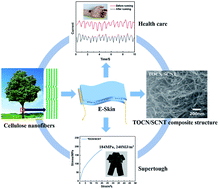Supertough and ultrasensitive flexible electronic skin based on nanocellulose/sulfonated carbon nanotube hydrogel films†
Abstract
With increasing interest and demand for wearable sensor devices, fabricating a flexible hydrogel film sensor combining high strength and high sensitivity for monitoring human physiological signals is necessary but remains challenging. Recently, we have successfully prepared flexible piezoresistive electronic skin (E-skin) using 2,2,6,6-tetramethylpiperidinyl-1-oxyl (TEMPO)-oxidized cellulose nanofibrils (TOCNs) and sulfonated multi-walled carbon nanotubes (SCNTs). The flexible sensor exhibited an extremely high sensitivity of about 4.4 kPa−1, an ultrafast response time below 10 ms, an ultralow detection limit of 0.5 Pa, good stability (>11 000 cycles) and a mechanical strength of up to 184 MPa. At the same time, the pressure sensor had the advantages of a simple preparation process, low time consumption, low cost and good biocompatibility. With the popularity of smart terminal devices, the flexible sensor has great application prospects in the fields of future wearable electronic devices, health monitoring, motion monitoring, intelligent prosthetics, and artificial intelligence.



 Please wait while we load your content...
Please wait while we load your content...